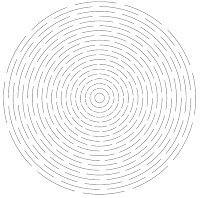I made a interactive pattern generator in Processing. Aspects of the pattern are controlled by moving the scrubs around the outside of the circle. It should be capable of generating over 4 billion unique patterns (some nicer than others). Here are a couple screen shots of it in action:
The patterns it produces tend to be quite intricate. You might need to look up close at your screen in order to really appreciate each pattern (not recommended with CRT's). These following images are the direct output from the program (click to see there full size (which actually isn't a whole lot bigger)).
Continue reading to see many more.
August 11, 2011
August 9, 2011
Paper Dome
I found a great project that an aspiring architect had made. They created a certain pattern in Rhino and then had that pattern cut out via a laser cutter. They then turned the cut 2D pattern into a 3D structure by placing a support rod in its center. The result was an inspiring and beautiful creation.
I decided to take on the task of creating one of these structures for myself. The main difference is that they had literally thousands of dollars worth of program and equipment at their disposal and I did not.
So my first step was to create the pattern in a printable format. In a few hours I wrote a program that generates the pattern based on a few customizable variables and exports it to PDF for easy printing. I wrote the program in Processing so this part was completely free. I made a few variations of the pattern and took them over to the print shop. I printed $0.90 worth of copies. Then I choose one I liked the most and spent about a half hour cutting each line by hand with a razor knife.
Here is the pattern I went with (it's scaled down a bit and saved as a PNG because Blogger won't let me post the PDF):
I found some cardboard, tape, and a nail that I already had around the house. Here are my final results:
For a total materials cost cost of under a dollar, and using a program I wrote myself, I'm pretty happy with the results. No question a laser cuter would create a more perfect structure though. The small deviations in the cuts by hand lead to uneven tension in the top of the dome. However, the individual dome you see here has an out of pocket cost of 15 cents. All and all, this was a fun experiment and I am quite happy with the results.
I decided to take on the task of creating one of these structures for myself. The main difference is that they had literally thousands of dollars worth of program and equipment at their disposal and I did not.
So my first step was to create the pattern in a printable format. In a few hours I wrote a program that generates the pattern based on a few customizable variables and exports it to PDF for easy printing. I wrote the program in Processing so this part was completely free. I made a few variations of the pattern and took them over to the print shop. I printed $0.90 worth of copies. Then I choose one I liked the most and spent about a half hour cutting each line by hand with a razor knife.
Here is the pattern I went with (it's scaled down a bit and saved as a PNG because Blogger won't let me post the PDF):
I found some cardboard, tape, and a nail that I already had around the house. Here are my final results:
For a total materials cost cost of under a dollar, and using a program I wrote myself, I'm pretty happy with the results. No question a laser cuter would create a more perfect structure though. The small deviations in the cuts by hand lead to uneven tension in the top of the dome. However, the individual dome you see here has an out of pocket cost of 15 cents. All and all, this was a fun experiment and I am quite happy with the results.
Subscribe to:
Posts (Atom)




